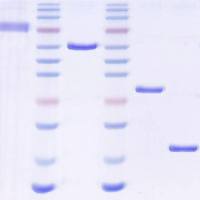Two-dimensional DNA displays for comparisons of bacterial genomes
互联网
689
We have developed two whole genome-scanning techniques to aid in the discovery of polymorphisms as well as horizontally acquired genes in prokaryotic organisms.First , two-dimensional bacterial genomic display (2DBGD) was developed using restriction enzyme fragmentation to separate genomic DNA based on size, and then employing denaturing gradient gel electrophoresis (DGGE) in the second dimension to exploit differences in sequence composition. This technique was used to generate high-resolution displays that enable the direct comparison of >800 genomic fragments simultaneously and can be adapted for the high-throughput comparison of bacterial genomes. 2DBGDs are capable of detecting acquired and altered DNA, however, only in very closely related strains. If used to compare more distantly related strains (e.g. different species within a genus) numerous small changes (i.e. small deletions and point mutations) unrelated to the interesting phenotype, would encumber the comparison of 2DBGDs. For this reason asecond method, bacterial comparative genomic hybridization (BCGH), was developed to directly compare bacterial genomes to identify gain or loss of genomic DNA. BCGH relies on performing 2DBGD on a pooled sample of genomic DNA from 2 strains to be compared and subsequently hybridizing the resulting 2DBGD blot separately with DNA from each individual strain. Unique spots (hybridization signals) represent foreign DNA. The identification of novel DNA is easily achieved by excising the DNA from a dried gel followed by subsequent cloning and sequencing. 2DBGD and BCGH thus represent novel high resolution genome scanning techniques for directly identifying altered and/or acquired DNA.







